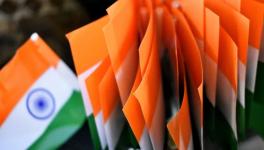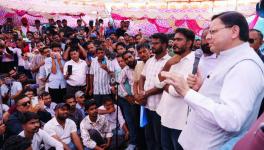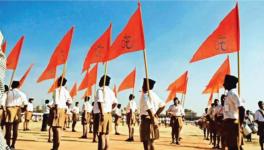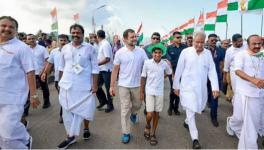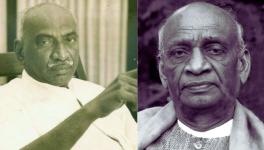It's 75 Years Since Historic Royal Indian Navy Revolt Shook the British Empire
Date: The morning of December 1, 1945
Venue: The parade ground of HMIS Talwar, the training and communications command of the Royal Indian Navy stationed in Bombay
On that morning 76 years ago, British naval officers woke up to see that the grand arrangements made at the parade ground to celebrate Navy Day with flags, buntings, and flowers had been ransacked, and trash was lying all around. Freshly painted graffiti and posters, with slogans like 'British, Quit India', were splashed all over the adjoining walls. The officers got into a tizzy as searches and raids were carried out at the hostels of the Indian naval ratings.
A rating who had forgotten to hide a bottle of gum in a rush was arrested on the wee hours of December 1, 1945. His name was Balai Chandra Dutt. When the sentries took him for interrogation, he shouted: "I am ready to face the firing squad." An infuriated commander of HMIS Talwar, FM King, later called the revolting naval ratings "sons of coolies and bitches”, which inflamed the situation further. As the news of Dutt's arrest spread the next day through the morning newspapers, there was uproar across the Bombay city with people coming out on the streets to protest. This arrest was a trigger for the week-long Royal Indian Navy (RIN) revolt that occurred 75 years ago, starting February 18, 1946.
December 1945 onwards, the ratings from the HMIS Talwar and the shore establishment Castle Barracks, who were already inspired by the role of the Indian National Army (INA) led by Subhash Chandra Bose, went around Bombay in lorries, waving the Congress tricolour and the Red Flag of the then undivided Communist Party of India (CPI), and got into scraps with Europeans and police officers who tried to confront them. People looted and ransacked British shops, a situation that continued for several days. As tension mounted, Dutt was released after 17 days. He returned to the barracks to plan out a full-scale mutiny.
Dutt was joined by several others from Talwar, RIN (Royal Indian Navy), Khyber and the Castle Barracks, including Kailash Narain Tikoo, Madan Singh and Phanibhushan Bhattacharya. The latter had a chequered past. He had earlier participated in the Quit India movement and served a prison sentence. On his release, Bhattacharya, who had by then become a CPI member, joined the Royal Indian Navy (RIN) under a plan to work with others like him inside the force and chalk out a strategy for a revolt from within. He was posted at the Castle Barracks, from where he started this work with those who were already functioning underground.
The CPI had planned out systematic infiltration of its eligible cadres, especially from Bengal and Maharashtra, to join the RIN for this purpose. Over the weeks thereon, such incidents started taking place on ships stationed in foreign waters ranging from Singapore to the Gulf, North Africa and Europe, as well as those lined up near the ports in Bombay, Karachi, Calcutta, Chittagong, Kochi, Madras, Vizag and Port Blair in the Andamans.
BACKGROUND
The planning for protests in the Royal Indian Navy had begun two years ago. The prime reasons were bad quality and quantity of food supplied to the Indian ratings, blatant discrimination in terms of pay and facilities between them and the British men of the same ranks, forced labour and the racist attitude of British officers towards them. But on the top were their political demands, namely 'British, Quit India' and release of the Indian National Army (INA) prisoners imprisoned in several prisons, including the Red Fort in Delhi. The Indian ratings and officers were influenced by the stories of the valiant INA struggles in Southeast Asia, Burma, Thailand, Singapore and later, Northeastern India, where the INA men had fought difficult battles with the British forces and the American air force. They learnt about the reports of these battles through the messages pouring in from the front through the British communication channels. Many of them were also part of the British forces stationed in Burma and fighting the "Japanese" army, which was, in effect, the INA forces.
Exactly a year after the August Kranti Andolan, on August 9, 1943, a secret Joint Action Committee (or the Central Strike Committee) of the three services was established with the RIN's Madan Lal Saxena, Royal Indian Army's Chandra Singh Garhwali and Royal Indian Air Force's P Kottayam heading it. It was decided that a revolt would be sparked off simultaneously at all bases of the three services on February 18, 1944. In the first phase, the issues of 'No Food, No Work' and discrimination would be raised. The next phase would be concerning the political demands.
But over the next few months, the British officers got wind of it. They arrested two women Navy officers, Urmila Bai and Anubha Sen. The strike committee then decided to advance the date of the revolt by a week to February 11, 1944. That day, a direct confrontation began between the Indian and British soldiers. On the orders of the Castle Barracks commander, the British troops opened fire upon the protesting Indian soldiers, who retaliated. The uprising happened in Bombay as well as in Karachi. A total of 35 British soldiers were killed and over 300 wounded in these two cities. On the Indian side, the toll was 11 dead and over 600 injured. More than 5,000 Indian naval ratings were arrested and court-martialled. The two Indian lady officers, Bai and Sen, were brutally tortured and raped and later shot dead. The planned revolt failed, but the fire continued to brew among the Indians in the three forces.
The Indian prisoners were released after weeks of agitations across India, and Phanibhushan Bhattacharya was one of them. Discharged from the Navy, he returned home, where his parents pressured him and got him married. Within days, he left a letter for his wife explaining the situation and again reached Bombay on November 9, 1945. He rejoined the Navy under a different name, P Apte, and was posted at the HMIS Talwar.
DECEMBER 1945 AND ONWARDS
Following the ransacking of the decorations on HMIS Talwar and Balai Dutt's arrest on December 1, 1945, protests broke out on the streets of Bombay, forcing him to be released in 17 days. After returning to the barracks, he resumed planning for another uprising with Kailash Narayan Tikoo, who came from Kashmir, and several others.
As per the latest plan, on February 18, 1946, the first spark was lit when Commander F M King and Flag Officer Arthur Rullion Rattray were gheraoed by Indian ratings who had given a call for 'Food Boycott'. Scuffles broke out between the protesters and British soldiers, and within a few hours, HMIS Talwar fell to the hands of the Indian ratings. The Union Jack was pulled down, and the Congress tri-colour and the Red Flag of the Communist Party were unfurled over the British warship. This sudden takeover took the people by surprise, with newspapers like the Free Press Journal publishing hour-by-hour stories about the uprising. As the word reached the Castle Barracks, British forces gathered and started firing towards HMIS Talwar. This attempt was thwarted by the people on the streets of Bombay, with mobs rushing towards the docks and confronting the British troops. In various parts of the city, the protestors damaged British owned shops. They pulled down the US flag from the American Library building, raising slogans like 'Inquilab Zindabad' and 'Hindu Muslim Ek ho'.
The insurrection on HMIS Talwar and Khyber saw Indian navy men on other warships docked along the Bombay coastline to follow suit. They joined their comrades on Talwar and Khyber, pulling down the British flag and flying the tri-colour and the Red Flag. Some also unfurled the Muslim League's green flag, along with the two others. A complete strike was observed in Bombay, its slums and industrial areas, with thousands marching on the streets towards the revolting ships, carrying the Red flag and tricolour. Such was the display of solidarity that people from the Dharavi slums tied plastic bags on their bodies and swam across to ships like Talwar and Khyber to supply food to the protesting naval ratings. Commenting on this display of unity and solidarity among all sections of the people, Marxist stalwart EMS Namboodiripad wrote, "That the flag of the working people was proudly flying in the ships and the establishments for the duration of the uprising, was an indication of the new social forces that were moving the thousands of men who had risen against British rule."
Another strike committee was formed to chalk out the further course of action with Signalman M S Khan and Dutt's friend Madan Singh as its President and Vice President. To begin with, the name of HMIS Talwar was changed to 'Indian Navy Talwar', which became the strike headquarters. Besides Talwar and Khyber, among the scores of other ships were 'Hindustan', 'Bahadur', 'Himalaya', 'Champak' and 'Kathiawad', many of them stationed in Karachi. Ships from as far as North Africa and Singapore had started for the Indian coasts to join the strike as the Indians took them over. As the news spread, contingents of the Indians in the army and airforce started preparing for similar protests.
On February 21, 1946, Indian army men led by the British opened heavy fire on the Indian naval ratings. But within minutes, the situation reversed completely as the protestors appealed on mikes to their counterparts of the Maratha Regiment, who the British officers ordered to open fire. "Brothers, our struggle is for freedom, and you too are the sons of this nation. We urge you to stop the fire," the protestors said. The firing stopped almost immediately. The men of the Maratha Regiment, then on, refused to take any orders from the British officers. The CPI issued a call for a general strike in Bombay for the next day (February 22) in solidarity with the striking ratings.
People from all walks of life poured into the streets – the young and the aged, the Hindus, the Muslims, the Christians and all other faiths, from the loaders in the docks to the rickshaw puller, the industrial workers and students from schools, colleges and universities. Shopkeepers downed their shutters. To check the rampaging mobs, the Britishers deployed men of the Gurkha Brigade, who were considered loyal. But the Gurkhas also refused to fire on the swarms of unarmed people who had taken over the streets of Bombay.
Scores of warships had by then taken down the Union Jack and unfurled the Red Flag and the Congress tri-colour and sailed from the high seas of the Mediterranean and African coasts towards Bombay and Karachi. Indian sailors aboard these warships refused to obey orders and sailed through the Bay of Bengal towards the eastern port cities of Chittagong, Calcutta, Vishakhapatnam and Madras. Communication channels with these sailors were opened from the ships carrying the leadership (Talwar and Khyber). As heavy firing was launched by the British on Talwar and Khyber, the strike leadership moved to a smaller ship, 'Narmada'. The then British Navy chief, Admiral John Henry Godfrey, who had rushed to India to take stock of the situation, was reported to have said that if this uprising could not be quelled, the entire British Navy would have to be disbanded. On his orders, the British forces blocked the lanes for the supply of food and materials to the striking ships. But the valiant people like fishermen and slum-dwellers of Dharavi tied plastic bags containing food packets and swam across to these ships.
The Bombay city remained tense through the few days of the strike. Hundreds were injured in firing and baton-charge, with thousands of others arrested. Similar was the situation in several other cities -- Karachi, Lahore, Delhi, Calcutta, Lucknow, Cawnpore, Hyderabad, Jabalpore, Cochin and Madras. These cities witnessed general strikes and bandhs amidst mass demonstrations and protest meetings. In Karachi, Amritsar and Jabalpore, airforce and army personnel also went on strike in solidarity with the ratings. In Calcutta, there were protests inside the headquarters in Fort Williams. In Bombay, Admiral Godfrey took to the radio and asked the British troops to use force to quell riotous mobs which burnt down British shops, pelted missiles and stones, dug up streets or barricaded them. It was reported that over a hundred British tanks came out on the streets.
A later assessment by the Bombay Presidency Governor reported that at least 228 persons were killed and 1,046 injured in the week-long violence in the city alone. According to noted historian Prof Subrata Mukherjee, the total number of ships affected by the revolt in India and abroad was 78. The number of shore establishments affected was 20, and an estimated 20,000 ratings and officers took part in the uprising.
THE ROLE OF INDIAN NATIONAL LEADERS
Having failed militarily, alarmed British rulers asked Indian national leaders to intervene and called for a cease-fire. They asked the top Congress and Muslim League leaders to invite the striking navy men for negotiations. On the advice of Sardar Vallabbhai Patel and Mohammad Ali Jinnah, the protesters decided to call off their strike and surrendered on February 23, 1946. However, they made it clear that they were surrendering to India (Indian leaders) and not the British rulers.
While the CPI and the Congress Socialist Party stood by the striking ratings, none, among the leaders like Mahatma Gandhi, Jinnah or Patel, sided with them. Patel reportedly later said the strike was planned by "a few hot-headed youngsters". Jawaharlal Nehru, however, remarked that the uprising had "opened an altogether new chapter in the history of the armed forces of India." While a few of these leaders suggested steps to end the discrimination regarding food, none of them made any statement supporting the striking ratings' call for 'Quit India' or freeing of the INA soldiers. Some of these leaders invited a team of striking ratings to negotiate with the British officers in Bombay and assured them that they would not be arrested when they came for these talks. But the entire team of naval strike leaders who came for the negotiations were arrested.
Faced with such a huge betrayal, Dutt later wrote, "We had planned to channelise the unrest towards a revolt against foreign rule, but we lost. We failed to take the insurrection we started towards its logical culmination. We cried like children, but the tears could not douse the flame of protest in our eyes."
On February 23, 1946, the ratings surrendered. Indian sailors on 78 ships laid down their arms and surrendered. The last message of the Naval Central Strike Committee termed the uprising as "a historic event in the life of our nation. For the first time, the blood of men in the services and the men in the streets flowed together in the common cause. We know also that you, our brothers and sisters, will not forget." This brought down the curtain on a historic insurrection after the 1857 Sepoy rebellion, which saw waves of protests culminating into a full-scale revolt in February 1946. It was also a critical factor that forced the British rulers to advance the date of granting independence to India, from June 1948 (they had planned earlier) to August 15, 1947.
Amitabha Roychowdhury has extensively covered internal security, defence and civil aviation for the Press Trust of India for over three decades. Views are personal.)
Get the latest reports & analysis with people's perspective on Protests, movements & deep analytical videos, discussions of the current affairs in your Telegram app. Subscribe to NewsClick's Telegram channel & get Real-Time updates on stories, as they get published on our website.













